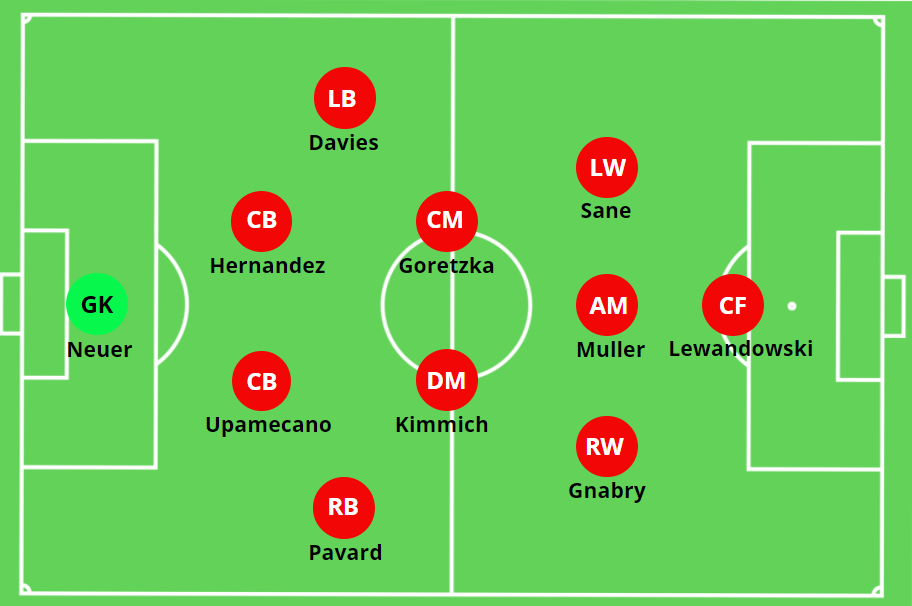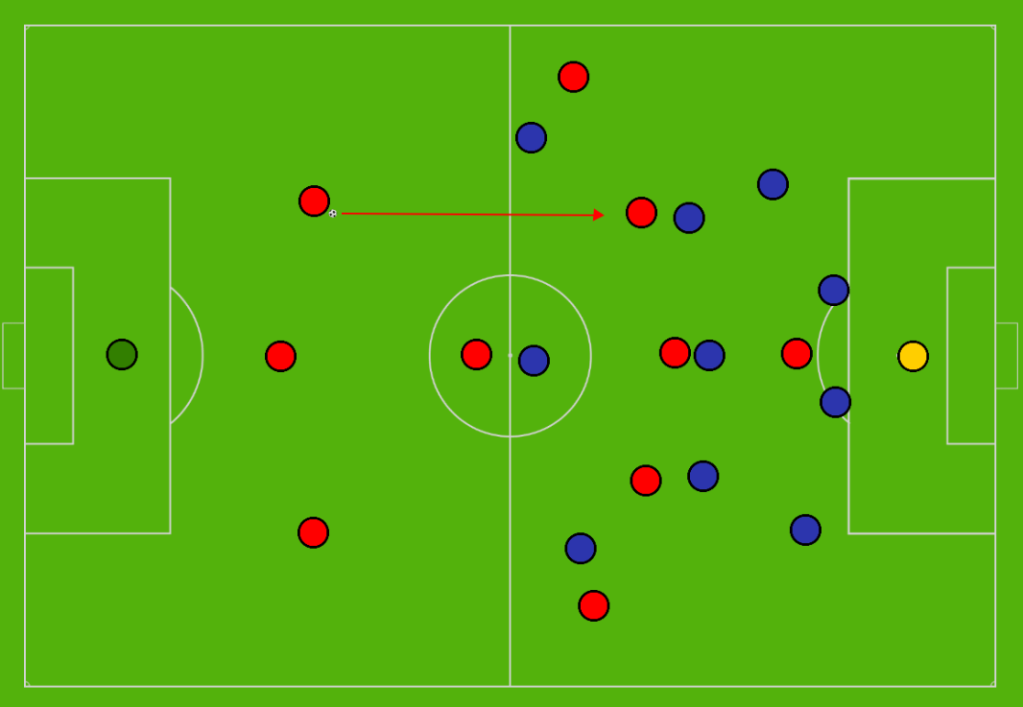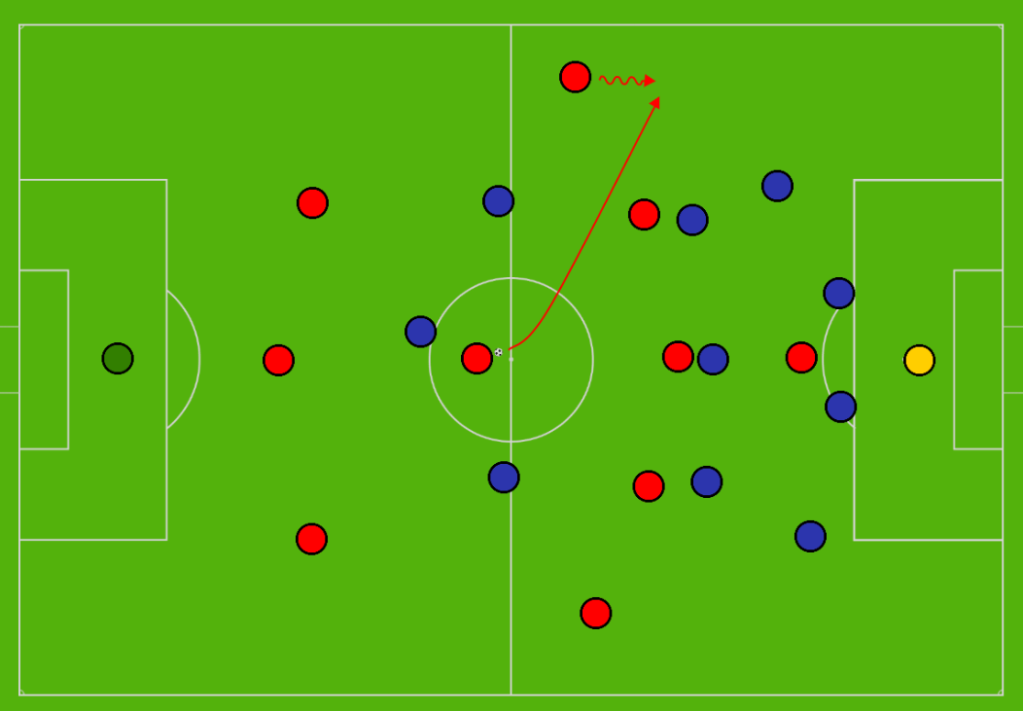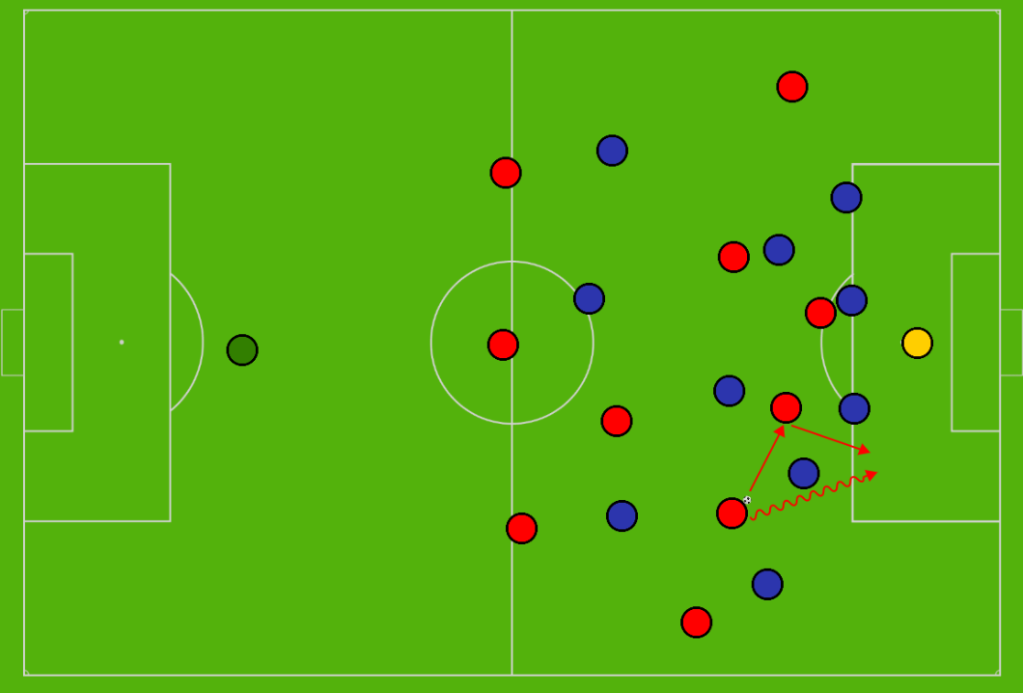Since taking charge of Bayern Munich, Julian Nagelsmann has only carried on his fantastic managerial reputation, with the Bavarians winning six of their opening eight matches. In that time they’ve scored a whopping 29 goals, playing an incredibly effective and attractive brand of football. Here is a tactical analysis of Julian Nagelsmann’s Bayern Munich in 2021-22.
system of play: 4-2-3-1

Julian Nagelsmann, as we suggested he might do, has eased into his role at Bayern Munich by deploying the same formation as his predecessor – Hansi Flick. Nagelsmann’s 4-2-3-1 looks very similar in application to Flick’s, both in functionality and personnel. There are a few notable changes to the lineup under the new boss however, including Dayot Upamecano coming in for the Real Madrid departed David Alaba, after the Frenchman followed Nagelsmann’s footsteps from Leipzig to Bayern. With Boateng out of the club, Lucas Hernandez has also played an important role this season ahead of Niklas Sule. Most importantly of all, Nagelsmann has completely reinstalled faith in Leroy Sane. Sane has been one of the key men in the Bayern team this year, fulfilling the promise many thought he could realistically reach years ago at City. Kingsley Coman’s dropped out of the team as a result, finding it difficult to enter the frame this season. But other than that, things have been pretty standard for Nagelsmann in his 4-2-3-1, as he eases into life at the Allianz.
In the future, Nagelsmann may experiment more with a 3-4-2-1, as they did against Greuther Furth, but that will likely require the team having a more natural right-wing-back. So for the time being, 4-2-3-1 is the shape. But in truth, it rarely ever looks like 4-2-3-1. While it’s true that this is Bayern’s most common defensive shape, it is also true that they rarely have to defend in their matches. Instead, they spend much of their time playing what resembles more of a 3-1-5-1, with players roaming around the attack and looking to receive in between the lines of the opposition.
build-up

Julian Nagelsmann’s team play out from the back in a 3+1 shape, involving the two centre-backs, the right-back and the defensive midfielder – Joshua Kimmich. This allows Alphonso Davies to constantly start from a higher, wider position, where he can then go on to do his best damage in attack. Leroy Sane as the left winger in the team will then invert into central areas, and Serge Gnabry may do the same. All of this allows Thomas Muller and Leon Goretzka to roam as they please and interpret space wherever they see it best serving the team in the moment. Muller for example may drift out to the wide right to receive, particularly when Gnabry floats inside. But with so many players gravitating towards the left, and Davies’ high starting position, this is often the side in which Bayern will look to start and even end their attacks. It’s one of the reasons why Sane and Davies have developed such a close relationship in attack this season, as Bayern often guide the play over to their side.

While Bayern Munich have scored a remarkable 29 goals this season so far, their build-up has remained relatively patient. The centre-backs pass the ball around between each other, looking for the best routes forward into Kimmich and into the players further up the field. While short passes are the dogmatic methodology, long passes are also used to quickly spring an attack, catch the opposition off guard, or switch play to the other side. Neuer, Upamecano and Kimmich have each completed over 5 long passes per game this season, with Sule and Hernandez both over 3 per game. Joshua Kimmich in particular has world class vision, and can pick out a pass from anywhere on the field. The German midfielder’s precision from deep is one of the most important facets of Bayern’s game, and one that allows them to constantly be in a cycle of chance creation. When you add Leon Goretzka’s excellent and rampaging movement from deep into the box, and the adeptness of someone like Muller or Sane to caress a ball down on a one-touch, Bayern can truly score goals from any direction.
Embed from Getty ImagesBut most often, die Roten opt to go short and pass the ball around between their centre-backs. Since they are rarely put under any sort of severe pressure, due to the greater threat in behind, Bayern are almost always afforded time and space to pick out their passes. That often allows the centre-backs to step out and carry the ball into the opposition half, which Upamecano and Sule like to do in particular. Kimmich may also operate higher in different moments, with Goretzka dropping deep instead. Other times, both midfield men may roam high as the centre-backs carry the ball into the opposition’s half. In these moments, Kimmich looks to create another number in central areas to compound the opposition’s misery.
So while Robert Lewandowski is incredible and probably the best player in the world at the moment, Bayern are by no means a one-man-team. This is highly evident from the ways in which the team are often patient in building out from the back, and finding the best route forward through the use of all ten others, before the ball even finds its way to the big Pole.
width & mobility
Embed from Getty ImagesNagelsmann’s Bayern operate under a high amount of positional freedom, fluctuation and rotation. This benefits a player with the adeptness of Thomas Muller as already mentioned, but also makes life incredibly difficult for the opposition in trying to stop everyone else.
Regardless of who is out wide and who is inside, Bayern will often guide their attacks to the wide areas with players like Sane and Davies or Muller and Gnabry in close proximity to make magic happen. We then see an array of overlapping and underlapping runs around the player with the ball, as Bayern step up their speed of play and look to progress vertically (but also diagonally) into the penalty area for an on-rushing attacker. With a player like Goretzka making an underlapping run at the same time Muller overlaps Gnabry, it becomes impossible to track Bayern and their exceptional movement off the ball. That’s because movement from one player almost always opens up space for another to receive, as the initial player’s movement draws defenders away.

In these situations they also use bounce passes to unlock an opposition defense, allowing a player seemingly blocked by three defenders to suddenly find space in behind. This use of width and mobility is absolutely essential to the way Bayern play, and how they score so many goals. Once in the final third, it’s also important to note how quickly they flood the box in numbers. Bayern are often able to catch flat footed defenders off guard as they swiftly move around the penalty area with ease, and get on the end of a low driven cross from the right, a Joshua Kimmich high-flyer, or a whipped ball in from Davies on the left. In transition they are equally deadly, looking for the quickest route to goal and often finding it through adamantly playing into their attackers at speed. They’ve completed a remarkable 4 through balls per game this season, even despite their long-passing game being a major feature.
pressing
Embed from Getty ImagesJulian Nagelsmann’s team hunt the ball back in numbers, looking to press from the front and restart their attacks. They have the fourth highest ratio of tackles per game at 17.4, despite also topping the table in possession (62.8%), and accumulating the least amount of fouls per game (8.5). This suggests that Nagelsmann’s men are incredibly effective at winning the ball back after putting pressure on their opposition, and at timing their tackles to perfection.
Since Alphonso Davies often starts very high in attack, Bayern’s pressing shape often looks a bit like a 3-4-3 or 3-4-2-1, with Leroy Sane pushing up alongside Thomas Muller and Robert Lewandowski. Sane’s role in this is also aided by the fact that he’s often inverted on the left in attack, with Muller rotating nicely with Gnabry on the other side. In longer spells without the ball they may drop into more of a 4-2-3-1 or 4-2-2-2 pressing shape, as Muller and Lewandowski work more as a tandem duo.
When it comes to the type of press, Nagelsmann’s Bayern could be considered to be deploying more of a man-oriented press, popularly associated right now with Bielsa’s Leeds. This means that Bayern players usually have a player in which it is their duty to stop – giving each individual a clear sense of their role in the structure. Whether it’s this approach or just an increase in intensity, Nagelsmann’s team have completed 2.4 tackles per game more than they did under Hansi Flick – a noticeable difference to an already high-pressing team.
set-pieces
Embed from Getty ImagesAs if they don’t already excel in all areas of the game, Bayern Munich are also incredibly adept from set-pieces. As the opposition attempt to mark the danger men like Muller and Lewandowski, they neglect other powerful players like Upamecano or Goretzka in the process. The ball is then whipped in from someone like Kimmich into a dangerous area, where an unmarked player is given room to easily knock it into a dangerous area, where you know Lewandowski or Muller are ready to pounce. This is an interesting paradox in that the opposition often spend so much time marking Lewandowski and Muller initially, that they forget they are still very capable of scoring from flick-on’s and second passes created by other players marked less diligently. With Lewandowski’s incredible awareness of space and the quickness of his movement to react before anyone else, he is often deadly from these situations.
Leroy Sane and Joshua Kimmich have also shown their astuteness in scoring directly from set-pieces in recent months, which compounds the issue further for the opposition in trying to stop Bayern’s set-pieces. The Bavarians have scored 5 goals from set-pieces so far this season in the league, with only Leipzig able to match their tally. Lewandowski’s claimed three, with Muller and Sane bagging the other two.
conclusion
Embed from Getty ImagesBayern Munich have been rampant at the start of this season, scoring 29 goals in just 8 matches so far, and topping the table on 19 points. Not only that, but the Bavarians are playing an attractive brand of football under Nagelsmann, involving positional rotation, meticulous build-up structures and quickness in the final-third. Whether or not they can challenge for another UEFA Champions League title remains to be seen, but for the time being, Bayern are certainly on the way to winning another Bundesliga title.
So there it is! A tactical analysis of Julian Nagelsmann’s magic touch at Bayern Munich so far. Be sure to check out more of our tactical analyses, and follow on social media @mastermindsite to never miss an update. Thanks for reading and see you soon!
you might also enjoy…
Pep Guardiola – Manchester City – Tactical Analysis (2023-24)
This might finally be the year. It might finally be the year that Pep Guardiola and Manchester City don’t win the Premier League. Despite that, they’ve still been the most tactically complex team in the league, carrying on from much of the tactics that brought them a treble-winning triumph last season. Here is what Pep…
Game of Numbers #38 – Alejandro Garnacho’s intensity & awareness
It’s amazing to think that Alejandro Garnacho is only 19 years of age. Sometimes, you can see the rawness in his game. The facets that still need to be carefully developed. But as he ages, let’s hope he never loses his tenacity. His hunger for more. His appetite to win at all costs, even when…
The EFL Championship’s most invigorating title race in years
For the longest time, Leicester City looked favourites for the EFL Championship title. Few competitions in the world of football can match the Championship for drama, but this 2023-24 campaign has now taken on a new level of excitement ahead of Easter Monday’s round of fixtures. Four teams remain in the hunt for the title…
PURCHASE OUR 4-3-3 GAME MODEL EXAMPLE –
They are not to be taken literal, although ideas can certainly be taken from this resource and implemented within your own team’s system and style of play. This game model example showcases what Rhyspect FC looks to do in each third of the pitch in all three defensive phases, and all three attacking phases. The game model also provides a brief look into set-pieces and player characteristics.





27 thoughts on “Julian Nagelsmann – Bayern Munich – Tactical Analysis”